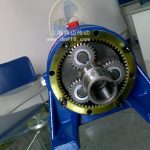Recently, a few customers have feedback that they don’t know there is a running-in period for reducer products and what to pay attention to during this period. Here, I will elaborate in detail on the issues that customers should focus on after purchasing a new reducer. If there are any deficiencies, I sincerely hope that all experts will generously offer their advice.
After a new reducer leaves the factory, it is usually stipulated that there is a running-in period of about 200 hours (the oil must be changed if the time is exceeded). This is determined by the technical characteristics of the reducer in the early stage of use. The running-in period plays a vital role in ensuring the normal operation of the reducer, reducing the incidence of faults, and extending its service life. The technicians of the reducer factory have particularly pointed out the following key precautions:
First, Precautions during the Running-in Period
1. The reasonable selection of lubricating oil is extremely important. Especially for reducers with an input power greater than 11KW, medium-load gear oil must be selected. Always check the oil level and quality of the lubricating oil, hydraulic oil, and coolant, and pay attention to the sealing of the entire machine. If a large amount of oil is found to be missing, the reasons should be analyzed in depth. During the running-in period, it is recommended to add lubricating grease to each lubrication point every week (except for special requirements). For vertical reducers with oil pumps, when connecting the power supply, pay attention to the rotation direction of the oil pump. Clockwise rotation is correct.
For example, in a certain factory, during the initial use of a new reducer, inappropriate lubricating oil was not selected, resulting in poor operation of the reducer and abnormal wear.
2. Keep the reducer clean, adjust and fasten the loose parts in time. Loose parts will not only aggravate the wear, but also may lead to the loss of parts.
For instance, in a certain production line, due to the failure to timely fasten the loose components of the reducer, parts fell off, affecting the production progress.
3. When the running-in period ends, it is necessary to conduct mandatory maintenance on the machine, complete comprehensive inspection and adjustment work, and pay attention to the replacement of the oil.
Second, Common Problems during the Running-in Period
1. Fast wear rate: The components of a new reducer will have certain influences during the processes of processing, assembly and debugging, resulting in a smaller contact area of the mating surfaces while the allowed torque is large. During operation, the concave and convex parts of the component surfaces are interlocked and rubbed, and the abraded metal debris will continue to be involved in the friction, accelerating the wear of the mating surfaces of the components. Therefore, during the running-in period, the components, especially the mating surfaces, are prone to wear and the wear rate is relatively fast. If it operates under overload at this time, it is very likely to cause component damage and trigger early failures.
2. Many operation errors: Due to the insufficient understanding of the structure and performance of the reducer by the operators, especially the new operators, faults are easily caused by improper operation, and even mechanical accidents and safety accidents.
3. Poor lubrication: The mating clearance of the newly assembled components is small. Coupled with assembly and other reasons, the lubricating oil (grease) is difficult to form a uniform oil film on the friction surface, unable to effectively prevent wear, thereby reducing the lubrication effect and causing abnormal early wear of the machine parts. In severe cases, it will cause scratches or bites on the mating friction surfaces and trigger faults.
4. Occurrence of loosening: The newly processed and assembled components have deviations in geometric shape and mating dimensions. In the initial stage of use, affected by alternating loads such as impact and vibration, as well as factors such as heating and deformation, coupled with the excessive wear, the originally fastened components are prone to loosening.
5. Occurrence of leakage phenomenon: Due to factors such as component loosening, vibration, and heating of the reducer, leakage may occur at the sealing surfaces and pipe joints of the reducer. Some casting defects are difficult to detect during assembly and commissioning, but they will be exposed during operation under the effects of vibration and impact, manifested as oil leakage (seepage). Therefore, leakage may occasionally occur during the running-in period.
In conclusion, during the running-in period of the reducer, it is necessary to strengthen training, reduce the load, conduct close inspections, and enhance lubrication. As long as great attention is paid and the maintenance and servicing of the reducer during the running-in period are strictly implemented as required, the occurrence of early faults can be effectively reduced, the service life can be prolonged, the production efficiency can be improved, and the reducer can create more value for you.


